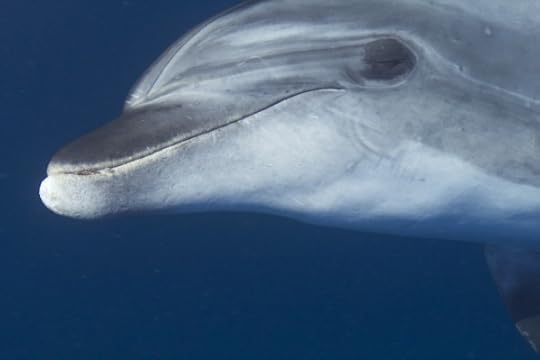Mark Caney's Blog, page 27
May 8, 2014
The Dolphins of War
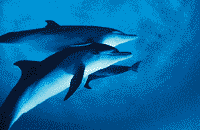
Both American and former Soviet navies have had top secret projects using dolphins for covert military purposes. John Davison investigates.
A Soviet Special Forces diver is parachuted from extreme altitude into sensitive waters. His secret mission is to use highly sophisticated sonar equipment to locate a piece of valuable military hardware which has accidentally splashed down in the wrong place. In the event of meeting an enemy diver, this Hero of the People is equipped with a futuristic weapon which will inject his adversary with 3,000psi of carbon dioxide and literally blow him up.
Sounds like a scene from the latest re-make of Thunderball? Well, all this really happened, and it gets better … or worse. The highly-trained operative was a dolphin.
The controversial use of dolphins and other sea mammals by the US Navy has been known about for a number of years, although the exact extent and nature of its activities is still shrouded in military secrecy. But details of the parallel Soviet developments in the field are only now starting to emerge, and they tell a fascinating, literally fantastic, Cold War story. They also beg the question as to whether the Americans have been doing the same things.
The idea of training airborne dolphins, for example, almost beggars belief. But conservation campaigners have seen the evidence and heard the tale first-hand from the former Soviet naval personnel who trained the animals to ‘jump’ from heights of up to three kilometres to avoid detection. Other dolphin ‘soldiers’ were pitched directly from helicopters hovering at 50 feet above the sea.
‘If I hadn’t seen the evidence myself I just wouldn’t have believed it,’ says Doug Cartlidge, a dolphin consultant and front-line campaigner with the Whale and Dolphin Conservation Society (WDCS). He visited the highly secret naval base at Sevastopol on the Black Sea, home to the once-proud Dolphin Division, to advise trainers on alternative uses for their expertise and on care of the animals, now that both are surplus to military requirement. While there he was shown around the unit’s museum and saw a full-size model of a dolphin wearing a parachute harness. He also saw official documents which described the programme.
Read full story: UKDiving.co.uk

May 6, 2014
Man Saved by Dolphins While Saving Dolphins
Call it a lucky break or just good karma: A pod of dolphins came to the aid of Adam Walker as he completed a fundraising swim to benefit the nonprofit Whale and Dolphin Conservation.
The British long-distance swimmer was in the midst of a 16-mile journey across New Zealand’s Cook Strait when he noticed a great white shark trailing beneath him. That’s when a group of 10 dolphins swept in and accompanied Walker until the shark swam off, about an hour later.
The pod might have been executing a rescue attempt or just having some fun with a fellow swimmer. Deliberate or not, this isn’t the first time dolphins have protected a human from danger in the water, preventing shark attacks and drownings or aiding broken-down boats.
Upon safely completing the swim in less than nine hours, Walker posted enthusiastically on Facebook, “I’d like to think they were protecting me and guiding me home!!!”
At the very least, the dolphins helped Walker finish the second to last of the Ocean’s Seven—a series of the world’s hardest long-distance ocean swims that only one other British person has ever completed. His last challenge, the North Channel separating Ireland and Scotland, hopefully will remain shark-free.
Source: Outside

April 30, 2014
“I wanna deliver a dolphin” story claims dolphin foetus can be placed in human womb
This synthetic biology project by designer Ai Hasegawa imagines that a woman could gestate and give birth to a baby from another species, in this case a dolphin, before eating it (+ movie).
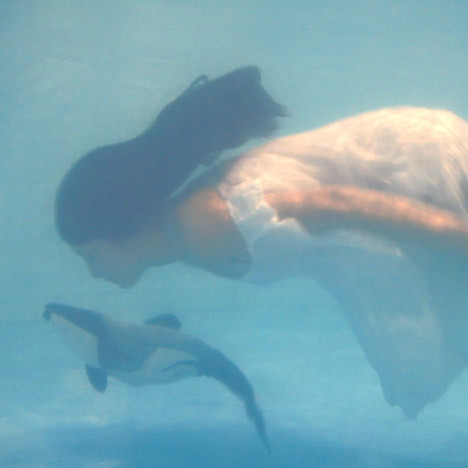
I Wanna Deliver a Dolphin… was developed by Ai Hasegawa to tackle food shortages and satisfy maternal instincts as the human population burgeons by giving women the option to become surrogates for endangered animals hunted for food.
Hasegawa proposes synthesising a placenta that could support an animal in a human womb.
“This project approaches the problem of human reproduction in an age of overcrowding, overdevelopment and environmental crisis,” Hasegawa said. “With potential food shortages and a population of nearly seven billion people, would a woman consider incubating and giving birth to an endangered species such as a shark, tuna or dolphin?”

The designer also questions whether someone would feel differently about eating a delicacy having personally carried and nurtured it.
“Would raising this animal as a child change its value so drastically that we would be unable to consume it because it would be imbued with the love of motherhood?” asked Hasegawa.
As a case study for the concept Hasegawa chose the Maui’s dolphin, one of the world’s smallest and most rare species of dolphin that has been critically endangered as a consequence of human fishing.
A Maui’s dolphin is roughly the same size as a human baby and is regarded as highly intelligent.
For a woman to gestate a dolphin, Hasegawa proposes biologically modifying a placenta to prevent the passage of antibodies from mother to baby that attack non-human cells.
“The placenta originates from the baby’s side, which in this case is a dolphin, and not from the human side,” said Hasegawa. “This avoids the ethical and legal difficulties associated with reproductive research involving human eggs.”
The “dolp-human” placenta would be altered to distinguish between mammal and non-mammal cells, rather than human and other cells, so the foetus would escape attack from the antibodies.
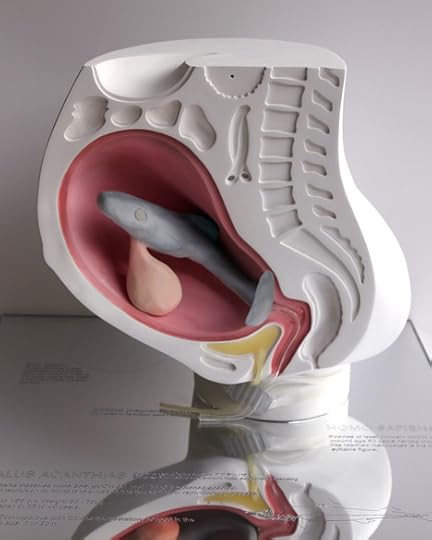
After birth, the mother would have to administer fat-rich synthesised milk to the baby to build it’s immune system, which a dolphin would naturally get from its mother’s milk rather than via the placenta.
Hasegawa first showed the idea at the Royal College of Art graduate show earlier this year and the project is currently on display as part of Grow Your Own… Life After Nature, an exhibition of synthetic biology projects at the Science Gallery in Dublin.
The exhibition also features synthetic living creatures that could be released into the wild to save endangered species and a proposal to use animal cells to print new types of organs for preventing heart attacks or strokes.
Here’s the information from Ai Hasegawa:
I Wanna Deliver A Dolphin…
Humans are genetically predisposed to raise children as a way of passing on their genes to the next generation. For some, the struggle to raise a child in decent conditions is becoming harder due to gross overpopulation and an increasingly strained global environment.
This project approaches the problem of human reproduction in an age of overcrowding, overdevelopment and environmental crisis. With potential food shortages and a population of nearly seven billion people, would a woman consider incubating and giving birth to an endangered species such as a shark, tuna or dolphin? This project introduces the argument for giving birth to our food to satisfy our demands for nutrition and childbirth, and discusses some of the technical details of how this might be possible.
Would raising this animal as a child change its value so drastically that we would be unable to consume it because it would be imbued with the love of motherhood? The Maui’s dolphin has been chosen as the ideal “baby” for this piece. It is one of the world’s rarest and smallest dolphins, classified critically endangered by the International Union for Conservation’s Red List of Threatened Species (version 2.3) because of the side effects of fishing activity by humans, its size (which closely matches the size of a human baby), and its high intelligence level and communication abilities.
I Wanna Deliver a Dolphin… imagines a point in the future, where humans will help this species by the advanced technology of synthetic biology. A “dolp-human placenta” that allows a human female to deliver a dolphin is created, and thus humans can become a surrogate mother to endangered species. Furthermore, gourmets would be able to enjoy the luxury of eating a rare animal: an animal made by their own body, raising questions of the ownership of rare animal life, and life itself.
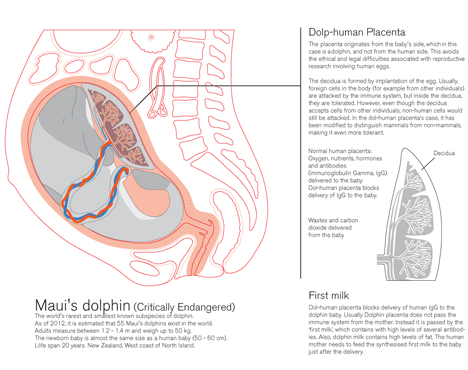 Diagram of dolphin foetus in a human womb plus explanation – click for larger image
Diagram of dolphin foetus in a human womb plus explanation – click for larger imageSynthetic Dolp-human Placenta
To make it possible for a human mother to deliver a dolphin from her womb, there is a need to synthesise “The Dolp-human Placenta”. The usual human placenta interacts to pass from mother to baby oxygen, carbon dioxide, nutrients, hormones, antibodies (Immunoglobulin Gamma, IgG) and so on. The Dolp-human placenta blocks the delivery of IgG to the baby.
The placenta originates from the baby’s side, which in this case is a dolphin, and not from the human side. This avoids the ethical and legal difficulties associated with reproductive research involving human eggs.
The decidua is formed by implantation of the egg. Usually, foreign cells in the body (for example from other individuals) are attacked by the immune system, but inside the decidua they are tolerated. However, even though the decidua accepts cells from other individuals, non-human cells would still be attacked. In the dolp-human placenta case, it has been modified to distinguish mammal from non-mammal cells, making it even more tolerant.
See video.
See full story: De Zeen

April 28, 2014
UFC fighter Cathal Pendred saves baby dolphin. No, really.

Yes, you read that correctly. UFC fighter Cathal Pendred spent this morning trying to save a baby dolphin and succeeded. The mixed martial artist was walking along Doonbeg Beach in Clare when he came upon a small baby dolphin that appeared to be drowning. Apparently, it’s common enough for dolphins to drown as they’re mammals and need air just like us.
Pendred dived into the sea and attempted to save the dolphin. Sure enough, he did and the little bugger swam off, happy as Larry. Here’s the tweet Pendred posted later that day.
Fair play, Pendred. Your PETA membership card is in the post.
Source: entertainment.ie

April 22, 2014
Dolphin wars in the Black Sea?
[image error]
The United States Navy has deployed military-trained dolphins to protect one of its warships in the Black Seaamid rising tensions with Russia over Ukraine, the Russiandaily Izvestia reported.
A Russian fighter jet made multiple close-range passes near the USS Donald Cook, a Navy destroyer, on April 12, two days after it entered the Black Sea, passing the Turkish straits. As the crisis in Ukraine deepened, U.S. ship commanders considered the Russian action provocative and inconsistent with international agreements, prompting the ship to issue several radio queries and warnings.
According to Izvestia, the U.S. Navy has recently established a safe zone around the USS Donald Cook by deploying 10 military dolphins. Some Russians claimed on social media the two countries may soon engage in “a dolphin battle” in the Black Sea.
There were reported claims from the Crimean peninsula late last month that Russian forces had “taken control” of Ukraine’s secretive military dolphin program.
Starting in 2017, 24 of the U.S. Navy’s 80 military-trained dolphins will be replaced by a 12-foot unmanned torpedo-shaped vehicle, according to a report published by the San Diego Union-Tribune in late 2012.
In recent years, U.S. Navy dolphins have been deployed to Iraq and Bahrain to patrol for enemy divers and mark the locations of mines. Using their innate sonar, the mammals find and mark mines in shallow water, deep water when tethers are used and on the bottom where sediment cover and plant growth can hide the devices.
Source: Hurriyet Daily News

April 17, 2014
Young Blind Boy Uses A Dolphin’s Sonar Ability To Help Him “See” The World
This video from “BBC Earth” discusses the sonar-like, “echolocation”, abilities which dolphins use to locate the world around them.  Sam, a young blind boy, is learning to use the same ability to help him navigate his own world.
Sam, a young blind boy, is learning to use the same ability to help him navigate his own world.
Milo the Dolphin uses Sonar to locate the world around him. Incredible school boy Sam is learning how to tap into this skill and become an echolocator.
The BBC has this fascinating video:
Source: LiveNews

April 10, 2014
April 8, 2014
Three Reasons Not to Keep Dolphins in a Tank
A bottlenose dolphin in the wild. (Photograph by Maddalena Bearzi)
By Maddalena Bearzi
I have spent much time in the company of wild dolphins over the last twenty-something years. I’ve built a career following their everyday movements and observing their behavior both from shore and from research boats. When I began my studies, I knew these creatures primarily as the objects of my research but, as the years passed, I came to recognize them as single individuals, not solely for their unique dorsal fin notches, but also for their cognitive abilities, personalities, and emotions.
Spending thousands of hours at sea, I began to know some of them by sight and, like my human friends, they became an integral part of my life. I learned of their needs, not only for space but also for companionship, and I witnessed their fluid, complex societies, which in many ways are quite similar to our own.
I have also witnessed first-hand the very different lives of these animals in aquaria and marine parks and I cannot help wondering about the reasons for keeping such magnificent creatures captive. In my line of work, I’ve heard all kinds of justifications for keeping dolphins confined, the most frequent being education, conservation, and research. (See: “First Person: How Far Will the Blackfish Effect Go?“)
Let’s consider whether any of these reasons are valid. And let’s do this keeping in mind that we are an allegedly intelligent and caring species with the ability to reflect and analyze what we currently know about dolphins and make sensible decisions based on these evaluations.
Keeping cetaceans (and personally I would stretch this to include other animals as well), in a restricted environment may have been more acceptable years ago, when we really didn’t know any better; when we didn’t have enough information about who these animals really are in the wild and what they need to live. But today, we know a lot more than we did back then.
So, what do we know about dolphins? Here, in a nutshell, are three important reasons why captivity and dolphins are incompatible.
1. Dolphins are large-brained, cognitive animals
If we consider ourselves as being at the pinnacle of intelligence, dolphins would come just after us, scoring even better than their great ape cousins. Looking at the Encephalization Quotient, which represents a measure of relative brain size and a rough estimate of the intelligence of an animal, dolphins possess a high EQ due to their unusually large brain-to-body- size ratios.
The last two decades have seen the proliferation of anatomical and morphological investigations on cetaceans. Neuroanatomical studies of their brains have shown that dolphins possess an intricate and developed neocortex as compared to other species, including humans, and a distinctive folding of the cerebral cortex, which in cetaceans is even more prominent than in primates.
Why is this important? Because, simply stated, these structures are both associated with complex information processing. Dolphins also have spindle-shaped neurons, or von Economo neurons, which are key for social cognition and have been linked in humans to an ability to “sense” what others are thinking.
There is no doubt that intelligence is difficult to define and when we look into the animal world, almost any animal may be considered “smart” depending on what definition of intelligence we decide to apply. I can make a great case for any of my dogs… But only in a few species like dolphins, great apes, and humans, do we find brain complexity, social complexity, and ecological complexity closely linked, at least for now… (See: “Schoolchildren and Musicians Boycott SeaWorld in ‘Blackfish’ Flap.”)
2. Dolphins live in complex societies in the open ocean
We have established that dolphins have large and complex brains, but what is all this brain capacity good for? This brain has allowed dolphins to develop complex and fluid societies in which they can flourish against the backdrop of a challenging, three-dimensional liquid environment.
Cetaceans such as the bottlenose dolphin (the most common species found in aquaria and marine parks today) have flexible and remarkable social and communication skills. They live in social networks characterized by highly differentiated relationships that often rely on precise memory of who owes whom a favor and who is a true friend. They engage in cooperative hunting and they partition resources such that prey is shared throughout the social group.
In some dolphin populations, males form coalitions in order to sexually coerce females or defeat other male coalitions. They care for each other; mothers and calves have long-term strong social bonds and a calf can spend up to two years next to its mother learning its place in the ocean. Dolphins play, bond, imitate, learn from each other and transfer information from generation to generation.
This ability to transfer learned behaviors to their progeny makes them cultural animals like us. And like us, they can recognize themselves as individuals and are self-aware, even if the extent of dolphin self-awareness still remains to be explored.
At sea, dolphins are always on the move, often traveling hundreds, sometimes thousands of miles. Their large brains likely help them to succeed in foraging on widely scattered and temporarily available resources. Dolphins, like some other animals, are essentially complex social mammals that need expansive space to live in. A tank can’t even begin to address these needs…
3. Dolphins have emotions (and personalities)
We like to think of dolphins as happy animals with an omnipresent smile frolicking in the sea. We tend to anthropomorphize them, projecting our own attributes on them. But what we think is the blissful face of a dolphin can obscure the animal’s true feeling, especially when we keep them confined. Let’s not forget that dolphins also die smiling!
Dolphins, like us, have a limbic system and are able to experience a broad spectrum of emotions including joy, grief, frustration, anger, and love. Put a dolphin in an MRI scanner and you will see a large brain structure that allows for complex emotions. Looking closer at a dolphin’s brain, once again, you will find those specialized von Economo neurons that in humans are linked to intuition and empathy.
But brains and neurons aside, it’s spending time in company of these animals in the wild that will really make a case for them as emotional beings with diverse personalities. Anyone who has witnessed the compassion of a dolphin mother in taking care of her calf, an individual helping a companion in distress, or a dolphin grieving for hours, even days for the death of a next of kin, can’t deny these animals have emotions.
Like intelligence, conscious emotion in these ocean-dwellers is difficult to understand, define, and measure. For comparison, just reflect upon how difficult it is to know what we ourselves are thinking or feeling at any given moment…
Now, let’s try something different. Let’s ignore all the scientific studies or what we currently know about dolphins. Let’s also disregard the three above-mentioned assertions why keeping these animals in captivity is fundamentally wrong, and let’s instead concentrate on debunking the favorite pro-captivity arguments: research, education, and conservation.
Read full story: National Geographic

April 5, 2014
Military Dolphins: What Do They Do and Who Uses Them?
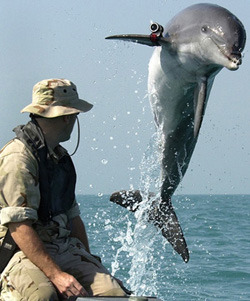 Russian activities in Crimea now include taking over a Ukrainian military unit made up of bottlenose dolphins, according to news reports.
Russian activities in Crimea now include taking over a Ukrainian military unit made up of bottlenose dolphins, according to news reports.
It’s unclear how the Russian navy intends to use these “combat dolphins,” although state-run Russian news agency RIA Novosti reports that the mammals will be getting equipment upgrades.
Using marine mammals like dolphins, whales, or sea lions for military purposes isn’t new. Nor is it restricted to the Ukrainian or Russian navies—the U.S. Navy has had a similar program since the 1960s. The ability of these animals to detect and find targets at depth or in murky water is something technology can’t duplicate yet, but which militaries find very valuable.
The Sevastopol-based “combat dolphins” are trained to search for and tag underwater mines or unwanted divers or swimmers attempting to access restricted waterways, says RIA Novosti.
Full story: National Geographic

April 3, 2014
Breakthrough in development of two-way dolphin-to-English translator
It sounds crazy, but if recent research turns out to be legitimate, we might soon be able to talk to dolphins via a two-way dolphin-whistle-to-English translator.
Researchers have been trying to decode and understand the various clicks and whistles made by dolphins since the 1960s, but mid-way through last year, after decades of experimentation, they made a huge breakthrough. For the first time ever, scientists were able to instantly translate a dolphin whistle into its corresponding English word.
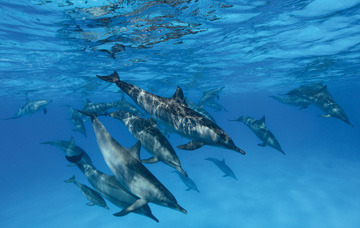 It happened back in August of 2013, when Denise Herzing, founder of the Wild Dolphin Project in Jupiter, Fla., was swimming in the Caribbean and listening to the dolphin pod she had been tracking for the past 25 years. Using a special listening/translation system called CHAT, Herzing suddenly heard the word “sargassum” (a genus of seaweed) come through her headset.
It happened back in August of 2013, when Denise Herzing, founder of the Wild Dolphin Project in Jupiter, Fla., was swimming in the Caribbean and listening to the dolphin pod she had been tracking for the past 25 years. Using a special listening/translation system called CHAT, Herzing suddenly heard the word “sargassum” (a genus of seaweed) come through her headset.
The specific whistle for “sargassum” was actually a word that Herzing and her team had invented in dolphin-speak. Since the late ’90s, they’ve been using artificial sounds that mimic real dolphin noises, and teaching them to the pod in hopes that the dolphins would eventually adopt them and incorporate them into their own communications. When the whistle came out, it was picked up by a pair of hydrophones, recognized/translated instantaneously with CHAT ( short for Cetacean Hearing and Telemetry), and then spoken back to her in English.
In addition to listening for these kinds of invented whistles, Herzing and her team hope to figure out how to translate the natural communications of dolphins as well. The CHAT system (developed by Georgia Tech professor and Google Glass project lead Thad Starner) is designed with a pair of finely-tuned hydrophones that can pick up the full range of dolphin sounds — many of which are imperceptible to human ears. Once recorded, the software sifts through all the different whistles, and uses pattern discovery algorithms to pinpoint language features. It starts by labeling noises that deviate from an assumed average state, and then groups ones that are similar to one another –sets of clicks or whistles with a distinct sonic signature– until all potentially meaningful patterns are extracted.
The secret to success here is repetition. Over time, if dolphins are exchanging information using these noises, then their behavior wouldn’t be completely random. There’s likely to be some discoverable patterns that could be recorded, codified, and eventually translated. With the help of today’s sophisticated information processing tools, figuring out those patterns is easier than ever. Starner’s algorithms have already discovered eight distinct components from a sample of 73 whistles, and they’ve begun to match certain parts of those whistles to specific dolphin-to-dolphin interactions. The research is still coming along, but it’s extremely promising, and could very well yield a working two-way dolphin-to-human translator in the next few years
Source: Digital Trends



